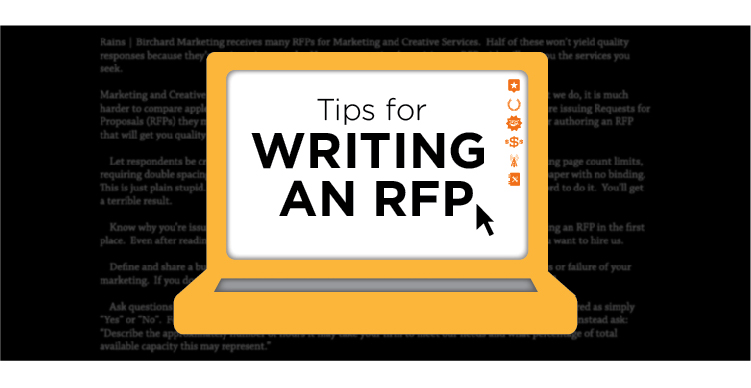When companies or organizations determine a specific need outside their scope of capabilities, they will often put out a call for proposals from organizations that can meet those needs and provide services for specific projects. Through this Request For Proposal (RFP) process, companies are able to obtain the credentials and experience of a number of potential partners and more easily compare those credentials side by side.
If you’re new to the RFP process, it may feel daunting and time consuming. However, once you’ve created a standard process for creating strong, customizable content, visuals that represent your company and brand, and catalog your standard responses, you’ll feel well-prepared to present your company’s credentials and excited for each new opportunity that comes your way.
Following are 8 steps to consider to ensure an impactful RFP, to leverage your time, and to create an efficient and repeatable process.
Step 1: Ensure the RFP is the Right Fit for Your Organization
The RFP process can take time and dedicated resources from your team. It will save time in the long run to have a system in place that allows you to quickly qualify potential RFPs. Is the company that is issuing the RFP an organization you can see yourself working alongside? Does your business offering and team experience meet the criteria needed for the project? Have you evaluated the risk, timing, budget and strategic fit to ensure the opportunity is the right one for your organization? Once you determine the opportunity is one you would like to pursue, then it’s time to get your system in place to respond with a strong proposal that highlights why you would be the best fit for the job!
Step 2: Write a Strong and Compelling Cover Letter
The RFP cover letter is your chance to make a great first impression. This is the first opportunity for a potential client to learn why you’re interested in working with them, your areas of expertise, what sets you apart, and what drives your organization and makes you the best fit for their project. As you’re often limited to a one-to-two-page cover letter response, it’s advised you quickly establish your expertise and interest and then highlight or bullet information that you will expand upon in the remainder of the response. Do your research and really work to understand the potential client, their company history, the specific project needs, and how your two organizations would create a strong partnership. Potential clients will appreciate that you took the time to understand their organization and that you highlighted how your company fits with their own vision and goals.
Step 3: Immediately Address Your Expertise and How it Meets the Selection Criteria
This section of an RFP is often the most crucial and thoroughly reviewed information. Every client looking to hire resources outside their own doors will need to feel confident in your ability to provide the requested services, meet the outlined project goals, respect their proposed timelines and budgets, and provide exceptional service as if you’re one of their own. When providing content for this section, ensure that you are immediately highlighting your areas of expertise, the specific services you will provide, why your company and team are best suited for the client, and how you foresee being able to not only meet their goals, but exceed them. When possible, it’s also advised to outline the specific goals and metrics that you will meet, provide your expected timelines, and highlight final deliverables for the client. More than anything, you want your potential client to immediately feel at ease that you are the expert and that they would be making a smart choice in choosing you as their partner.
Step 4: Provide Project Examples that are Relevant to the Client
In most cases, a potential client will ask for project examples that showcase your past professional experience and how it aligns with the proposal at hand. This is your opportunity to highlight your industry expertise, service offerings, and how you’ve helped your clients reach their business goals. When selecting clients to showcase, think about their direct relevance to the potential client and how that client would draw parallels to the work you’ve already performed and what you would provide for them to meet their needs and goals. When providing client examples, immediately draw attention to your client’s challenges, how you addressed them, how you added value, and how it positively impacted your client’s businesses in the long term. Providing before and after photos, relevant project stats, and short client testimonials will also create a strong client project response. If presenting more than one project example, ensure the format of your information is similar and the impact of your contributions are front and center.
Step 5: Present a Strong Team from Your Organization
With each RFP, you have the opportunity to put your best foot forward and present your dream team of individuals who would most closely align with the potential client’s needs. This is your chance to showcase individuals in your organization who have vast experience in the client’s industry, have created incredible value for your own clients, won awards on behalf of clients, contributed to your overall organizational success, and would bring that same level of professionalism and expertise to the potential client’s business. When presenting your dream team, it’s always advised to include full names, titles, a summary of their relevant industry experience, and the role that individual would serve for the potential client. Unless requested to submit bios in a specific format, bios of moderate length with a list of client experience and accolades is standard. When writing bios for RFPs, establish a standard format you will use to keep the bios similar in length, information, and tone. Headshots should be professional photographs and have a similar background and feel.
Step 6. Follow All Proposal Formatting and Delivery Instructions
In some cases, you will receive specific format instructions with an RFP. For example, a certain word count or number of pages per question, specific supporting documents may be requested, or financial charts may be required. It is always advised to follow the format requests exactly as they have been asked, as companies are often comparing multiple responses to one another and these specific requests enable them to ensure all information they have requested has been submitted uniformly. Similarly, if specific delivery instructions are provided, pay special attention to how a potential client has asked you to submit the RFP and follow those instructions precisely. In some cases, you are asked to send both a hard copy via mail and submit an electronic copy. Or you may be asked to upload your RFP to a central website or send multiple copies to numerous people in different offices. In some cases, government RFPs will require additional financial and legal documents that must be submitted. Above all else, always strive to submit your RFP before the required date to show your commitment to the client and attention to the deadline. You don’t want to miss the opportunity to be considered by simply missing a crucial submission detail!
Step 7: Create a Template to Follow for All Future RFPs
One of the greatest ways to leverage the RFP process is to create a template to use with each response and an internal system to pull information commonly asked in RFPs. For example, you can create a standard response for your company background information, client lists, executive bios and headshots, list of services, office locations, etc. This will allow you to pull information together quickly and ensure you have a consistent response in your proposals. You may also want to have specific client case studies written in advance with client stats, project photos, highlights, and results. Standard formats for bios and team credentials are also helpful to have in advance so you can easily pull information together when asked to assemble a new team. Once you have your information finalized, save it in easily accessible folders for anyone who may need to pull this information for future RFPs or modify it for a similar, but uniquely different proposal requests. Cataloging your RPFs in an easy to access folder will allow for future efficiencies and consistency.
Step 8: Outsource the Process to Maximize Your Time
If you’re a small business, or an organization without the internal staff to manage the RFP process, you can also outsource this task to marketing agencies that are well versed in submitting RFPs. Outside firms will have graphic design teams on-hand to create visually appealing responses, copywriters to help you hone your message, and they can manage the timelines, document requests, and RFP process for you from start to finish. Often times, outsourcing this task can free you up to do what you do best, run your business and serve your clients, and it allows you to better manage your time and resources through each RFP submission.
With every RFP opportunity, you want to put your best foot forward and treat it like you’re submitting a resume for your dream job. Your goal should always be to showcase what you do best, call attention to the synergies between your two organizations, and highlight your dedication to helping your potential client reach their business goals.
At Threaded Marketing Group, we specialize in the RFP process. Reach out to us if you want to learn more about how we can help you create winning RFPs each and every time.


